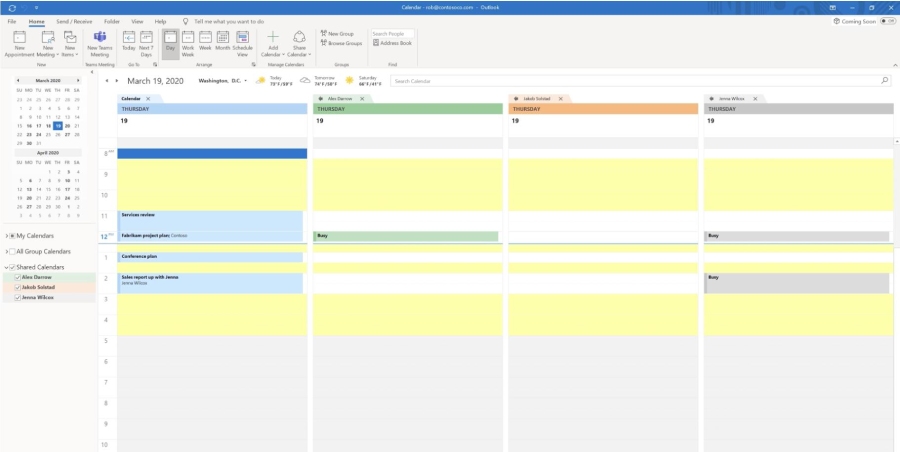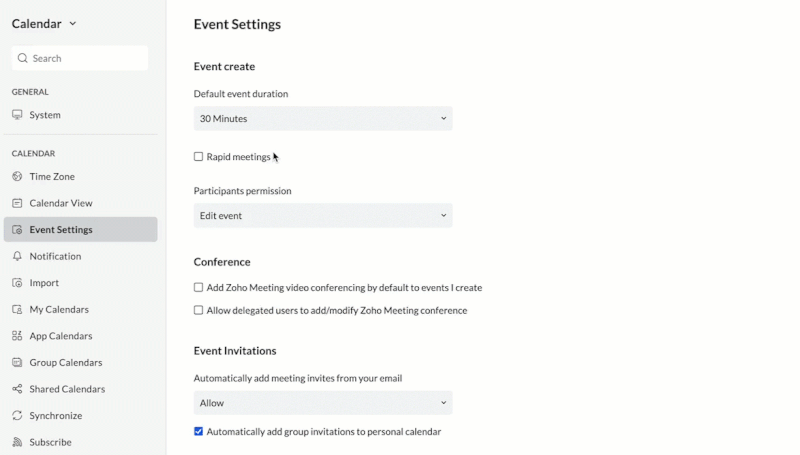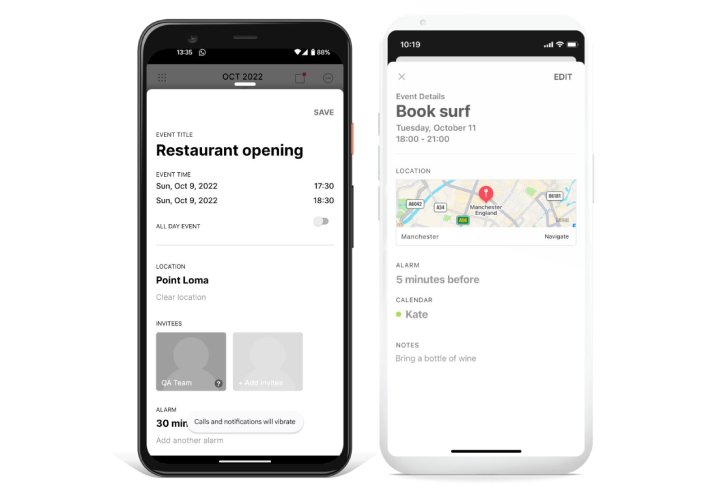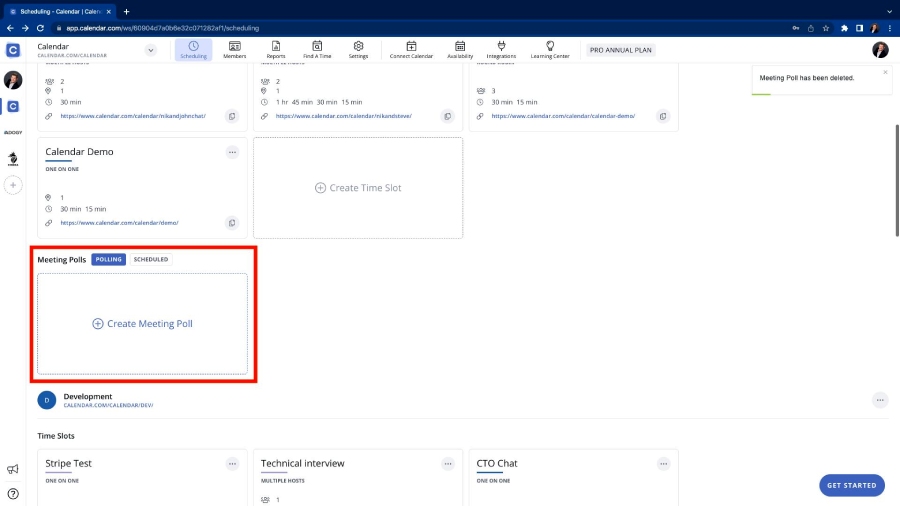The best calendar app lets users create meetings and appointments with only a few clicks or taps on their computers or smartphones. It offers multiple calendar views and allows syncing of external calendars, like holiday schedules, making event scheduling easier. Moreover, it benefits remote teams with members worldwide, as it features working hours and time zones guiding decisions for booking dates and times for virtual events.
Based on our research, these are the best calendar apps:
- Google Calendar: Best overall for easy event scheduling
- Outlook Calendar: Ideal for schedule availability checks
- Zoho Calendar: Great for resource booking
- Any.do: Top pick for task management
- Calendar.com: Solid choice for calendar analytics
Best Calendar Apps at a Glance
Best Calendar Apps | Monthly Starting Price | Key Features | Supported Platforms | FSB Rating |
|---|---|---|---|---|
$7.20 per user |
|
| 4.52 out of 5 | |
$6 per user |
|
| 4.32 out of 5 | |
$4 per user |
|
| 4.27 out of 5 | |
$3 |
|
| 3.57 out of 5 | |
$25 per user |
|
| 3.51 out of 5 | |
Google Calendar: Best Overall for Easy Event Scheduling
What We Liked
- Free plan for small businesses
- Smooth scheduling of video meetings via Google Meet integration
- Team members' schedules are readily visible
Where It Falls Behind
- Requires a Google account, which is a hassle if you use a different service
- Notifications are hit and miss
- Limited customization tools for the interface
Google Calendar Monthly Pricing*
- Essentials Starter: Free for calendar views, task management, event notifications, and 15GB of cloud storage
- Business Starter: $7.20 per user for conference room browsing and reservation, RSVP options, and 30GB of pooled storage
- Business Standard: $14.40 per user for appointment booking pages and 2TB of pooled storage
- Business Plus: $21.60 per user for calendar status display, working location, time insights, and 5TB of pooled storage
- Business Advanced: Custom pricing for 5TB of pooled storage and the option to add more
- Free trial: 14 days
*Google Calendar is part of the Google Workspace ecosystem. The Starter, Standard, and Plus plans’ fees lower to $6, $12, and $18, respectively, when you pay annually.
Google Calendar is our overall best calendar app mainly because it packs advanced capabilities while providing a simple, easy-to-use interface. It allows users to instantly create new events and send invitations to team members. Since it seamlessly integrates with Meet, it automatically generates a meeting room for remote participants.
As for the individuals attending activities on site, Google Calendar invites contain room details, as the platform lets organizers book resources. It’s easy to track who’s coming to scheduled events as guests are encouraged to respond to event invitations. The calendar software supports various collaboration tools, enabling users to create team calendars, view co-workers’ schedules, set working hours and time zones, and assign tasks.
Through its integration with Google Docs, Slides, Sheets, and Drive, you’ll easily share meeting notes and supporting materials before and after the event. While Google Calendar is an excellent platform, it lacks customization options. In contrast, Zoho Calendar enables you to change font sizes and themes, while Calendar.com offers white-labeling solutions, allowing you to channel your own branding in the interface.
Google Calendar Features

Configure working hours on Google Calendar.
(Source: Google Workspace)
- Working hours: Set working hours to inform colleagues when you’re working and available for meetings. This is especially beneficial for global teams working across different time zones.
- Working location: In the same way you’re able to set your work schedule, you can display where you’re working from also. With this, event organizers get an idea if the invited participants can go physically or virtually to the scheduled activity.
- External event invitations: Google Calendar automatically prompts you to confirm sending event invitations to emails outside of your domain. If you frequently set meetings with external stakeholders, disable the prompt to quickly send out invites.
Outlook Calendar: Best for Schedule Availability Checking
What We Liked
- Schedules are easy to follow thanks to color-coded entries
- Seamless insertion of calendar in emails
- Recognizes natural language phrases, like “today” or “next week,” in event creation
Where It Falls Behind
- Doesn’t offer interface customization options
- Less flexible pricing, given the lack of monthly billing set-up
- Doesn't have a standalone mobile app like Google Calendar
Outlook Calendar Monthly Pricing*
- Personal: Free
- Basic: $6 per user
- Standard: $12.50 per user
- Premium: $22 per user
- Free trial: 30 days
All paid subscription plans offer meeting schedules and reminders, calendar sharing, delegate access, and side-by-side and overlay calendar views.
*Outlook Calendar is part of the Microsoft 365 ecosystem. The pricing is for annual billing. The provider doesn’t offer a monthly billing option.
Outlook Calendar is the best calendar app for checking schedule availability, featuring different calendar view layouts. Its “calendar peek” lets you see upcoming events right from your mail when you point to the calendar icon in the main navigation bar. Choosing the “Dock the Peek” option makes the calendar permanently visible in the Outlook window.
The non-traditional view allows you to configure the work week and display only your working days and times. For instance, hospital employees are able to set their calendars to show only their 12-hour shifts on select days. Outlook Calendar also features an overlay view, where different team members’ calendars are stacked, making it easier to determine which dates are available for virtual events.
However, unlike Google Calendar, Outlook Calendar doesn’t have a standalone mobile app. You must open your Microsoft Outlook app to access it. This is an inconvenience to some, especially when you don’t want to be distracted by emails and only need to check your schedule for the day.
Outlook Calendar Features

Check available time slots for meetings by using Outlook’s shared calendar. (Source: Outlook Calendar)
- Shared calendar: See team members’ schedules alongside yours to see available time slots for future meetings. Create this shared calendar by clicking the “Add Calendar” option in the main tab and selecting relevant contacts’ names from the address book.
- Appointment creation: Appointments are scheduled events solely for the user and thus won’t require inviting other people. When you create a new appointment, the system lets you enter its start and end time.
- Duplicate meetings: Copy-paste a previous meeting to create a follow-up meeting schedule faster. With this, you’ll avoid the hassle of manually filling out event descriptions, names of participants, and venue details.
Zoho Calendar: Best for Resource Booking

What We Liked
- Supports 60 languages
- Advanced search functionality
- Option to retrieve deleted events
Where It Falls Behind
- Sync problems
- Mobile app lags
- Difficulties integrating with third-party apps
Zoho Calendar Monthly Pricing*
- Free: Event scheduling, appointment creation, and calendar embedding on websites
- Standard: $4 per user for 30GB of mail storage per user and 10GB of cloud storage shared by three to 10 users
- Professional: $7 per user for 100GB of mail storage per user and 100GB of cloud storage shared by three to 10 users
Paid subscription plans include shared calendars, resource booking, and events imported from other online calendars.
Zoho Calendar Annual Pricing:
- Mail-only plan: $1 per user for shared calendars, group calendars, appointment scheduling, calendar sync, and calendar on mobile
*Zoho Calendar is part of the Zoho Workspace ecosystem. The Standard and Professional plans’ fees lower to $3 and $6, respectively, when you pay annually.
Zoho Calendar is the ideal calendar app for improving resource booking because it features a comprehensive system for managing and reserving facilities within the office. Administrators are able to enter the company’s specific branches, rooms, and facility equipment to make them available for easy booking. Team members reserving rooms for face-to-face meetings will find all the details about the space in Zoho Calendar’s resource booking system.
You’ll know each available room’s type, seating capacity, and equipment inclusions, such as monitor, projector, and whiteboard. The best part about Zoho Calendar is it generates resource booking reports, providing insights about the total number of meetings held for specific rooms and the types of facilities most used within a given period. This should inform your strategies for maintaining office spaces.
Zoho Calendar has the best calendar integration with other Zoho solutions, such as our top pick for project management software Zoho Projects, as well as Tasks, Contacts, and Zoho CRM. However, do note that the platform doesn’t work well with external business tools. Calendar.com offers better connectivity and native third-party integrations.
Zoho Calendar Features

Launch shorter virtual discussions with Zoho Calendar’s Rapid Meetings. (Source: Zoho)
- Event time proposal: If a team member isn’t available at the time set on the meeting invitation, they have the option to propose a new time. The system sends a notification to the organizer, and they can accept or reject the time proposal.
- Rapid meetings: Zoho Meetings shortens online discussions, changing the default event duration. Sessions that are 45 minutes or less are cut short by five minutes, while those exceeding 45 minutes will be trimmed by 10 minutes.
- Subscribed calendars: Access other types of calendars, such as the ones made public by a Zoho user, created in Zoho Projects, and recorded in Zoho Contacts. Subscribe to holidays and other public calendars using a URL.
Any.do: Best for Task Management

What We Liked
- Clean, easy-to-navigate user interface
- Features desktop and mobile widgets
- Affordable subscription plans
Where It Falls Behind
- Lacks advanced calendar features other providers offer
- Native integrations are limited to Gmail, WhatsApp, and Siri
- Less flexible pricing, given the lack of monthly billing setup
Any.do Monthly Pricing*
- Personal: Free for calendar views and built-in reminders
- Premium: $3 for custom themes and third-party integrations
- Teams: $5 per user for unlimited team members, collaborative workspace, and 100-plus+ workflow templates
- Free trial: 7 days
*The pricing is for annual billing (no monthly billing option).
Any.do is our top recommended calendar app for teams collaborating on time-sensitive projects because its built-in task management system lets you create to-do’s and monitor them closely. Its “My Day” feature shows a list of tickable tasks for the day. To help users come up with a strategic task list, Any.do has a smart suggestions engine that offers personalized recommendations of to-do’s, based on various criteria elements, like dates and priorities.
Aside from “My Day,” the platform features the “Next seven days view,” outlining the week’s assigned tasks sorted per weekday. With calendar dates matched with assignments, it’s easier for team members to keep track of deadlines and ensure that nothing is overlooked.
Unfortunately, Any.do isn’t the best calendar integration software, as its native integrations are limited to three apps only. Moreover, it lacks advanced calendar functionalities, like resource booking or video meetings. Google Calendar is still the best option for feature-rich calendar software. Most unified communications tools, like RingCentral, permit account connections with Google Calendar.
Any.do Features

Change the event’s name, time and duration, and attendees using Any.do’s event menu. (Source: Any.do)
- Universal search: Find calendar events and reminders easily by typing relevant keywords on the search bar. The mobile app has popular filters that help locate elements faster.
- Event menu: Edit events recorded in your personal calendar. The calendar software allows users to change the following details: event name, time and duration, invited participants, and notes.
- Calendar integration: Sync your smartphone’s native calendar to Any.do. As you create to-do lists on the platform, you won’t have to switch apps when checking schedules and booking activities on the calendar.
Calendar.com: Best for Calendar Analytics

What We Liked
- Advanced features, such as customizable calendar links and meeting schedule polls
- Integrations with popular customer relationship management (CRM) tools, like HubSpot and Salesforce
- Connects with popular calendars
Where It Falls Behind
- More expensive than other providers
- Doesn’t have a desktop app
- Billing issues
Calendar.com Monthly Pricing*
- Basic: Free for personalized calendar link, connection with one third-party calendar, one customizable scheduling time slot, and one basic workspace
- Standard: $25 per user for connections with three third-party calendars, five customizable scheduling time slots, private time slot links, and unlimited scheduler blocks
- Pro: $30 per user for connections with 10 third-party calendars, 50 workspace teams, unlimited scheduling time slots, and text reminders
- Enterprise: Custom pricing for single sign-on support, system for cross-domain identity management (SCIM) user provisioning, and expedited support
- Free trial: 14 days
*Save more than 20% by paying annually.
Calendar.com is the best shared calendar app for teams wanting to make meetings more efficient, as it offers easy-to-use calendar analytics. It provides an overview of the number of sessions you attended at a given period and the hours you spent. It shows a graph of your most common meeting schedules. With these insights, you’ll learn how much time you devote to huddles and if you’re taking advantage of the most productive times to schedule discussions.
Aside from meeting insights, calendar analytics offers people insights, displaying a list of individuals you come into contact with in these meetings. This is a beneficial tool for mentors who strive to be diligent and committed in meetups with mentees.
Unfortunately, Calendar.com’s subscription rates are more expensive than other providers. If affordability is your concern, the best alternatives to this platform are Zoho Calendar and Any.do. These platforms have a starting cost of $4 per user and $3 monthly, respectively.
Calendar.com Features

Create a poll to know what time team members are free for meetings. (Source: Calendar.com)
- Meeting poll: Let team members vote when they want meetings to happen. From the majority of the votes, schedule the virtual discussion.
- Private time slot link: Keep specific time slots reserved for certain individuals. The time slots you set as private won’t appear on the scheduling page, restricting some team members from booking a meeting with you.
- Short messaging service (SMS) reminders: Enable the system to send a text alert before a scheduled activity. Configure the time for alerts—you have the option to set the reminder an hour or five minutes prior.
How We Evaluated the Best Calendar Apps
To assess the top calendar apps, we considered each provider’s subscription costs, unique capabilities, usability, and customer assistance. Our evaluation also includes our expert opinion on its value for money and popularity.
Learn how we evaluated the best calendar apps by clicking on the tabs below:
15% of Overall Score
To determine affordability, we checked if the provider offers a free version. We considered the cost of the base-level subscription plan and compared it to the prevailing fee in the market. In addition, we favored those with discounts for annual billing.
25% of Overall Score
The general capabilities we looked at were email notifications and out-of-office features. Since businesses need a reliable communications platform for on-the-go employees, we included mobile apps in our assessment. Those with time tracking and timesheets got more points.
20% of Overall Score
The specialized features we checked were encryption, scheduling reports, and the ability to import and export. We also checked the third-party integrations the providers offer.
10% of Overall Score
We evaluated ease of use by determining the expertise required to set up and operate the phone system. We gave providers with an intuitive interface higher points.
10% of Overall Score
The variety of customer communication channels was part of our evaluation. We favored providers with email, phone, and live chat support while considering the hours these channels are active and operational.
20% of Overall Score
This includes our evaluation of the provider’s standout features, value for money, and ease of use. We checked user ratings in third-party review sites to gauge the platform’s popularity.
Frequently Asked Questions (FAQs)
According to the Statista 2022 report, Google Workspace has the largest market share in office productivity software. It can be argued that its built-in calendar is one of the most frequently used apps by businesses. Its intuitive interface and seamless integration with Google Meet make Google Calendar an excellent platform choice.
When looking for a calendar app, consider the following features:
- Calendar views: Go for platforms offering a wide variety of calendar layouts: day, multi-day, week, year, list of events, and side-by-side another user’s calendar. It’s easier to schedule meetings and see which activities to prepare for when you’re able to configure calendar views.
- Notifications: Some platforms notify via email, while others send alerts on the device. Choose an app that lets you receive reminders through your preferred communication channels.
- Team collaboration tools: Consider shared calendars, working hours, RSVP options, and task management systems when choosing a calendar app to help your team easily coordinate schedules and work on project deadlines.
- Analytics: This feature lets you know how much time you spend on specific activities, thus enabling you to make strategic steps for improving time management and productivity.
- Integrations: The workflow is easier if your calendar app connects with the platforms you already use. Look for a solution that integrates with a wide variety of third-party business apps.
Yes, all the platforms mentioned in this buyer’s guide have free versions: Google Calendar, Outlook Calendar, Zoho Calendar, Any.do, and Calendar.com. However, some features may not be accessible until you pay for the subscription plans. If you’re looking for an affordable calendar app, go for Any.do, which only costs $3 a month.
Bottom Line
An excellent calendar app helps businesses arrange meeting schedules easily, keep track of deadlines, and monitor how much of team members’ time is spent on different tasks and activities. Among the best calendar software solutions we reviewed, Google Calendar comes out as the best overall for its robust capabilities and clean, intuitive interface.
With this platform, you’ll easily create events, manage facility reservations, view other team members’ schedules, assign tasks, and collaborate via integrated Google products, like Meet, Drive, and Chat. Sign up for Google Workspace’s 14-day free trial to see if it suits your needs.